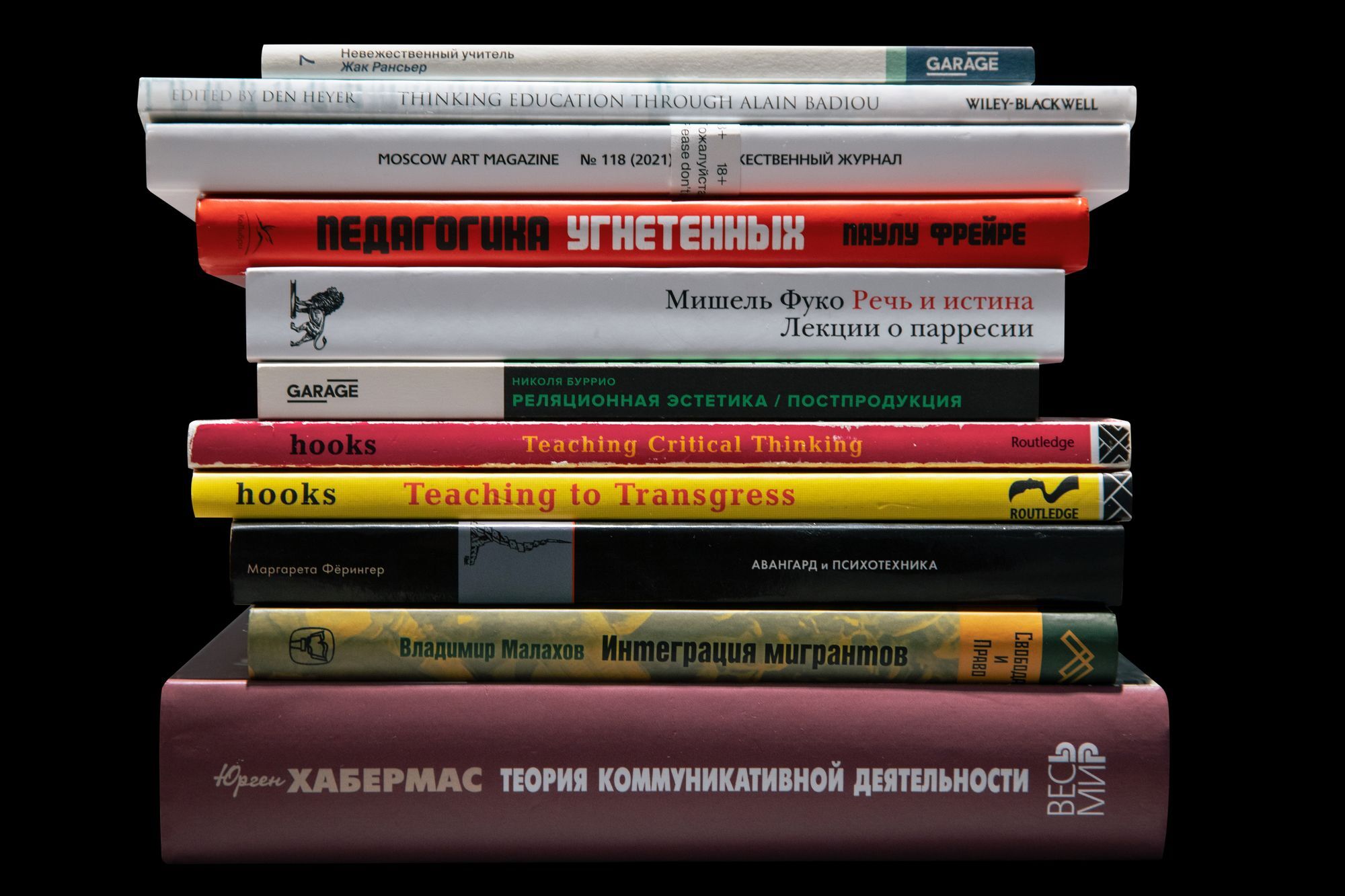A collection compiled by specialists at
Mediation Book Collection
- Age restrictions
- 18+

Photo: Ruslan Shavaleev
The thematic bookshelf in the library space was compiled as a reflection on the theoretical and practical foundations of mediation. Since mediation is a dynamic practice still in its formative stages, this collection includes texts from various fields of knowledge that invite us to contemplate the potential and role of the viewer in a broad sense, as well as rhetoric, forms of knowledge and methods of its transmission, museology, and media theory.
Official partner of the
In his work The Emancipated Spectator (Russian edition), French philosopher Jacques Rancière proposes a re-evaluation of the classic artistic dichotomy of “artist—spectator.” In contrast to contemporary artistic practices, where the “passive” spectator is “activated,” Rancière introduces the concept of intellectual emancipation, which is based on the intrinsic value of the spectator and the hierarchical equality between the creator and the observer. As Rancière writes: “We do not have to transform spectators into actors, and ignoramuses into scholars. We have to recognise the knowledge at work in the ignoramus and the activity peculiar to the spectator.”
In her book Artificial Hells: Participatory Art and the Politics of Spectatorship (Russian edition), art historian Claire Bishop presents a theory of participatory, or socially engaged, art, which she proposed in the early twenty-first century. The work builds on the conversation that began in the 1990s about the changing role of the spectator in performative practices. Bishop suggests considering participation art as the inclusion of the spectator in the process of producing culture and art.
Mediation is the practice of interaction between a cultural institution and its visitors, aimed at fostering a respectful dialogue among all participants in the process. The mediation department at the
The concept of “spectatorship” is closely linked to the notion of publicity. Based on the premise that the public exists within a specific space, Jürgen Habermas develops the theory of the public sphere. The scholar argues that not all spectators can be considered part of the public. In his work The Structural Transformation of the Public Sphere, the philosopher identifies the defining characteristic of the public as the possession of its own opinion, formed through dialogue.
In another important work, The Theory of Communicative Action (Russian edition), Habermas addresses issues related to the formation and development of communicative space. For Habermas, communicative space is rational; it encompasses not only the realm of verbal information exchange but also other environments, including situations that regulate and guide society or the public.
The theoretical aspects of mediation not only address the rethinking of the viewer’s role but also the relationship between the status of the student and the teacher. In the collective monograph Anarchism and Education, a detailed historiography of education based on anarchist philosophy is presented. The work outlines specific examples of attempts to implement libertarian ideas over the past hundred years of the development of critical education.
Pedagogy of the Oppressed (Russian edition) is one of the most important texts in the field of critical pedagogy from the second half of the twentieth century. Paulo Freire, drawing on his own experience, explains why classical methods of pedagogy often lead to oppression rather than liberation. The author proposes his own method, which is partially based on anarchist pedagogical practices and partially on what Jacques Rancière described as the concept of the “ignorant schoolmaster.”
In the book The Ignorant Schoolmaster (Russian edition), Jacques Rancière challenges the figure of the teacher as the unquestioned authority on knowledge. He describes the method of Jean-Joseph Jacotot, who recognised the universal equality of intellect and the ability to learn. This chapter of educational history illustrates the possibility of emancipation through an egalitarian exchange of knowledge, as opposed to the imposition of a single, authoritative opinion.
The 118th issue of the Moscow Art Magazine (published in 2021) examines alternative forms of museum pedagogy and the concept of “unlearning,” aimed at detecting power structures in educational projects and rejecting them.
When discussing the transmission of knowledge, we primarily turn to methods of verbal exchange of opinions. Michel Foucault, in his collection of philosophical works Discourse and Truth (Russian edition), introduces the concept of parrhesia—a form of interaction between people in which freedom of speech and judgement not only exists but is also beneficial.
The collective monograph Excommunication: Three Inquiries in Media and Mediation (Russian edition) is not directly concerned with the practice of mediation within cultural institutions. Originally included in the selection as a joke, it ultimately presents a thought-provoking perspective on communication and media theory. Drawing on examples from ancient literature and philosophy within a critical theory framework, the authors explore mediation—the literal process of conveying a message—through three key modes: the exchange of interpretations, luminous immediacy, and the network of distributed knowledge.
Compilers
Vera Zamyslova is an art historian, PhD student at the Higher School of Economics (HSE), researcher of actionism and performance, and the curator of accessibility and programmes for people with neurodiversity at
Ekaterina Voronovich is a PhD candidate at Philosophy Faculty of Moscow State University (MSU), researcher of performance, and the head of the mediation department at
Sergey Kochkurov is the curator of mediation programmes at
This collection of texts, which will be gradually updated, may serve as a guide to the theory and practice of mediation or as an introduction to the specifics of the profession. We invite you to discuss all the works from the selection during mediator tours and other meeting formats with
